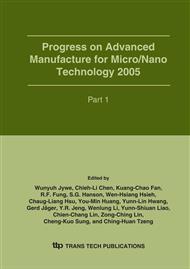p.535
p.541
p.547
p.553
p.559
p.565
p.571
p.577
p.583
Thermal Contact Residual Stress Analysis of Elastic-Plastic Bilayer Micro-Cantilevers with Platinum Electrodes
Abstract:
This paper studies the residual stress distributions and tip deflections of microfabricated bilayer cantilevers of varying beam thickness and platinum electrode length. The bilayer cantilevers discussed here are composed of low-stress silicon nitride films deposited on silicon beams. Platinum electrodes are deposited and patterned on the low-stress silicon nitride layers. A thermal elastic-plastic finite element model is utilized to calculate the residual stress distribution across the cantilever cross-section and to determine the cantilever tip deflection following heat treatment. A contact model is introduced to simulate the influence of contact on the residual stress distribution. The influences of the beam thickness and the platinum electrode length on the residual stress distribution and tip deflections are thoroughly investigated. The numerical results indicate that a smaller beam thickness leads to a larger compressive residual stress within the platinum electrode and delivers a larger tip deflection. The results also indicate that a larger platinum electrode length delivers a smaller tip deflection.
Info:
Periodical:
Pages:
559-564
Citation:
Online since:
January 2006
Authors:
Price:
Сopyright:
© 2006 Trans Tech Publications Ltd. All Rights Reserved
Share:
Citation:


